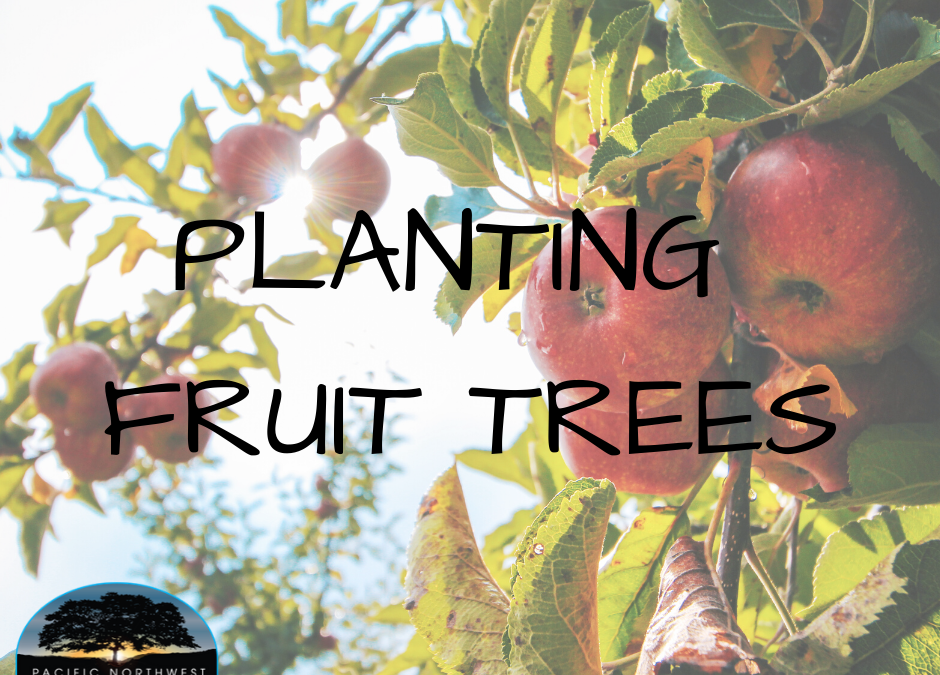Planting Fruit Trees
If you’re looking to upgrade your yard and gardening skills, then you may be considering adding fruit trees to your landscape. Adding fruit trees to your property not only welcomes more plant and color variety, but also gives you access to yummy fruits to eat at your leisure!
Due to the fact that all fruiting trees go dormant in the Winter, Spring is the best time to add fruit trees to your yard. Specifically, early Spring is the perfect time for planting these trees. This is because it is before the buds break from the branches, the ground is the right amount of damp, and the weather will not cause stress on the plant and its roots.
What’s wonderful about having fruit trees is that they can be trained to fit the space you have available, but you’ll have to give them extra care in the first year they are planted to ensure you’ll have fruits growing year after year. Keep reading to find out how to pick and properly plant and care for your backyard fruit tree!
CHOOSING YOUR TREE
Typically starting in February, you will be able to find fruit trees at your local nursery, where they should have a variety for you to choose from. Fruit trees can be purchased “bare rooted” (roots exposed, not potted) or as potted plants. Bare-root plants are often available earlier in the spring and can be considerably less expensive.
Some things you’ll want to keep in mind when you’re shopping for fruit trees are the growth factors that apply to the plants. Factors include: size or rootstock, pruning requirements, disease, pollination, soil type, nutritional requirements, and the sustainability to the climate. Luckily, most plants come with a tag that lists these factors, making your decision making a bit easier. It is a good rule of thumb to know how much space you have in order to determine which and how many plants are best suited for your yard.
Almost all fruit trees have gone through the propagating technique called grafting. Grafting is when a branch from a desirable fruit tree (called the scion) is attached to the base of a different variety (called the rootstock). The scion determines the type of fruit, and the rootstock determines the mature size of the tree. When shopping for fruit trees, you’ll likely see a range of graft options, including true-dwarf, dwarf, semi-dwarf or standard-sized trees. Dwarf or semi-dwarf trees work best for most settings because they result in smaller trees that are easier to manage than trees on a seedling rootstock.
TOP FRUIT TREE PICKS FOR BACKYARDS
• Apples
• Asian pears
• Cherries
• Figs
• Mulberries
• Pears
• Plums
PLANTING AND CARE
Choose the location:
While many species are somewhat forgiving of poor soil conditions, most prefer a site that is sunny and well-drained. Keep in mind the mature size of your tree. You’ll need to provide it with enough space to fully spread its branches in its new home. And make sure to check the acidity of your tree location — optimum soil pH for most fruit trees is about 6.5.
Dig a hole:
This can be a circle or square, but the hole should be twice as wide and the same depth as the root ball. Be sure not to dig too deep because loose soil underneath the tree will cause it to sink, making it difficult to establish a strong root system. Add a small amount of compost to the base of the hole and use a garden fork to mix the compost and soil, this is to avoid the roots hitting a sudden boundary of soil. Also, mix compost with the soil you removed so that it’s ready for when you use it to fill the hole.
Planting:
Trim off any broken roots and ones that are long enough to wrap around your planting hole. Place the trunk of the tree in the center of the hole, and fill in soil mixture on all sides, covering the roots. Water the soil as you go, and tamp it down, being mindful that you’re not breaking any roots. This helps close air pockets, stabilize the tree, and prevent root die-off.
Staking:
A strong and sturdy support will help the newly planted tree remain upright while it establishes a root system. Consider permanently staking dwarf or semi-dwarfing trees, as they may never develop a broad enough root system to support itself. The stake should stand at least as high as the tree’s lowest limb and be set just past the edge of the root ball. You can use tree-staking wraps from a garden center to tie the stake and tree together, or DIY methods such as old hose or nylons. Avoid using wire or any material that could gouge the tree and it grows. Add more soil mixture to secure the stake.
Mulching:
Apply mulch or a biodegradable hemp mat around the base of the tree to supply nutrients, conserve soil moisture, and suppress weeds. Keep the mulch at least 2 inches away from the trunk. Water the soil well to stop the roots from drying out and further settle the soil even more.
Care:
Water your new fruit tree regularly for at least the first three seasons after planting, especially during dry spells. The biggest failure when it comes to newly planted fruit trees is the lack of water they receive. A good soaking once or twice a week is perfect for promoting healthy, strong roots. Most fruit trees benefit from yearly pruning and fruit-thinning. It is vital to keep the area around the tree free of weeds and grass, as they will compete with a young tree for nutrients.
In the spring, it’s tempting to allow some blossom to develop into fruit. This can cause the tree to go under stress; however, removing all of it will ensure your tree establishes itself. You’ll miss out on the first years fruit, but the extra strength that your tree gains will guarantee your tree grows bumper crops in the following years.

